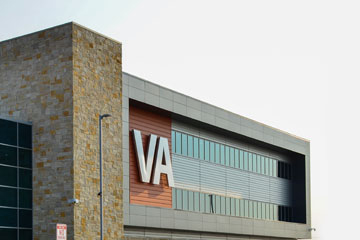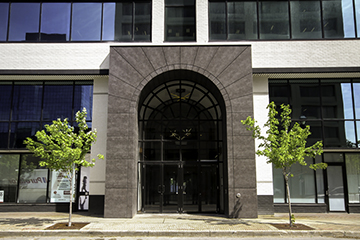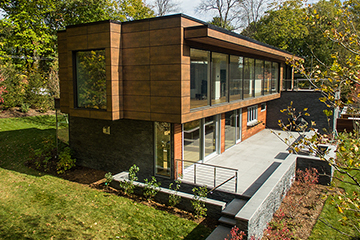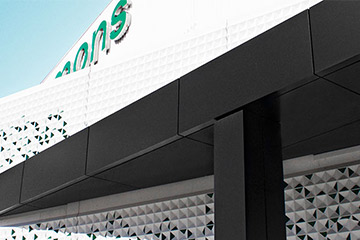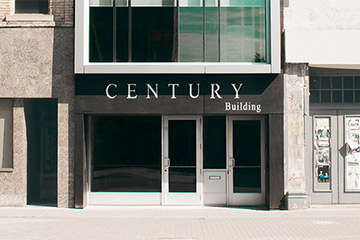Efflorescence is a common issue in masonry and concrete structures, often causing unsightly white staining that can affect the overall aesthetic of a building. For architects, designers, and builders, understanding efflorescence and how to prevent it is crucial in maintaining the integrity and appearance of a facade. Ceramitex by Elemex offers a modern solution that eliminates the risk of efflorescence while providing a durable and visually appealing exterior.
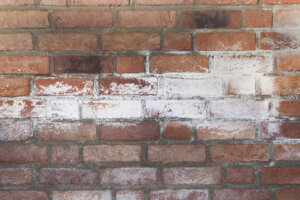

What is Efflorescence?
Efflorescence occurs when water-soluble salts migrate to the surface of a porous material—such as concrete, brick, stone, or stucco—where they form a visible, powdery deposit. This happens when moisture within the material dissolves these salts and then evaporates, leaving the salt residue behind. Efflorescence can manifest in two primary forms:
- Primary Efflorescence – This is a surface-level deposit that appears as white or grayish crystalline stains on masonry materials. While it may be removable through cleaning, it often recurs unless the root cause is addressed.
- Sub-Efflorescence (Spalling) – This occurs when trapped salts crystallize within the material itself, causing internal pressure that can lead to cracking, chipping, or surface degradation. Unlike primary efflorescence, spalling is significantly more damaging and costly to repair.
Why Efflorescence Occurs
Several factors contribute to efflorescence in masonry and concrete:
- Moisture Infiltration – Water is the key driver of efflorescence. When rainwater, humidity, or condensation penetrate porous materials, they dissolve salts within the structure and bring them to the surface.
- Salt Presence – The salts responsible for efflorescence can originate from various sources, including cement, mortar, soil, or de-icing agents.
- Evaporation Process – This occurs when trapped salts crystallize within the material itself, causing internal pressure that can lead to cracking, chipping, or surface degradation. Unlike primary efflorescence, spalling is significantly more damaging and costly to repair.
The Challenges of Efflorescence in Building Design
For architects and designers, efflorescence presents multiple challenges:
- Aesthetic Degradation – White or gray stains disrupt the clean lines and appearance of a building’s facade.
- Maintenance Burden – Regular cleaning is required to remove surface stains, which can be costly and time-consuming.
- Long-Term Damage – Sub-efflorescence can weaken masonry, leading to repairs or even structural issues over time.
- Client Dissatisfaction – Building owners and developers seek durable, low-maintenance solutions that won’t require constant upkeep.
A Smarter Solution: Ceramitex by Elemex
To eliminate the risk of efflorescence entirely, architects and builders are turning to Ceramitex by Elemex. This advanced sintered ceramic facade system provides a sleek, high-performance alternative to traditional masonry materials, ensuring long-lasting beauty without the drawbacks of efflorescence.
The Benefits of Ceramitex for Facades
Unlike conventional porous materials, Ceramitex sintered ceramic is engineered for exceptional durability and resistance to moisture:
- Non-Porous Surface – Unlike brick, stone, or concrete, Ceramitex does not absorb water, eliminating the root cause of efflorescence.
- Fade & Stain Resistance – The sintered ceramic finish maintains its pristine appearance, resisting staining from water, oils, and other environmental factors.
- Weatherproof Performance – Ceramitex facades withstand extreme weather conditions, including rain, snow, and humidity, without deterioration.
- Low Maintenance – With minimal cleaning required, building owners can enjoy a Corten steel facade look, stone effect, or other premium finishes without ongoing upkeep concerns.
- Lightweight & Easy Installation – Designed to integrate seamlessly with the Elemex Unity® attachment system, Ceramitex provides a simple, efficient facade solution.
The Elemex 360° Advantage
At Elemex, we don’t just deliver high-performance facade solutions—we provide an end-to-end support system through our 360° Advantage. This includes:
- Design Consultation – Helping architects and builders choose the best facade system for their project.
- Technical Support – Ensuring compliance with building codes and performance standards.
- Precision Fabrication – High-quality manufacturing processes guarantee consistency and durability.
- Seamless Installation – Our Unity® attachment system simplifies the installation process, saving time and reducing costs.
- Ongoing Service & Support – Long-term reliability backed by industry-leading expertise.
Why Architects Choose Ceramitex Over Traditional Masonry
For professionals seeking to avoid the common pitfalls of efflorescence while achieving a sleek, modern design, Ceramitex offers a superior alternative to brick, stone, and stucco.
Traditional masonry requires constant monitoring and maintenance to prevent water infiltration, salt migration, and staining. Even with sealants or Corten paint, materials can still degrade over time. Ceramitex sintered ceramic provides an ultra-durable, moisture-resistant solution that maintains its appearance for decades without requiring costly upkeep.
Elevate Your Facade with Ceramitex
At Elemex, we believe in building for the future—where beauty meets performance without compromise. With Ceramitex, architects and designers can achieve stunning, long-lasting facades without worrying about efflorescence, staining, or deterioration.
To learn more about Ceramitex facades and how they can transform your next project, contact us today at info@elemex.com or request a sample to experience the difference for yourself.
Elemex Architectural Facade Systems
530 Admiral Dr,
London, ON
N5V 0B2
Canada
+1 844-435-3639
https://elemex.com/




